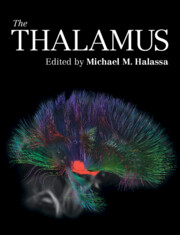Book contents
- The Thalamus
- The Thalamus
- Copyright page
- Contents
- Contributors
- Preface
- Section 1: History
- Section 2: Anatomy
- Section 3: Evolution
- Section 4: Development
- Section 5: Sensory Processing
- Chapter 9 Thalamocortical Interactions in the Primary Visual Cortex
- Chapter 10 Corticothalamic Feedback in Vision
- Chapter 11 The Vibrissa Sensorimotor System of Rodents: A View from the Sensory Thalamus
- Chapter 12 Corticothalamic Pathways in the Somatosensory System
- Chapter 13 Thalamocortical Circuits for Auditory Processing, Plasticity, and Perception
- Section 6: Motor Control
- Section 7: Cognition
- Section 8: Arousal
- Section 9: Computation
- Index
- References
Chapter 13 - Thalamocortical Circuits for Auditory Processing, Plasticity, and Perception
from Section 5: - Sensory Processing
Published online by Cambridge University Press: 12 August 2022
- The Thalamus
- The Thalamus
- Copyright page
- Contents
- Contributors
- Preface
- Section 1: History
- Section 2: Anatomy
- Section 3: Evolution
- Section 4: Development
- Section 5: Sensory Processing
- Chapter 9 Thalamocortical Interactions in the Primary Visual Cortex
- Chapter 10 Corticothalamic Feedback in Vision
- Chapter 11 The Vibrissa Sensorimotor System of Rodents: A View from the Sensory Thalamus
- Chapter 12 Corticothalamic Pathways in the Somatosensory System
- Chapter 13 Thalamocortical Circuits for Auditory Processing, Plasticity, and Perception
- Section 6: Motor Control
- Section 7: Cognition
- Section 8: Arousal
- Section 9: Computation
- Index
- References
Summary
The medial geniculate body (MGB) of the thalamus plays a critical role in transforming the dense, high-fidelity auditory coding of the brainstem and midbrain to the sparse, abstract coding used throughout the forebrain to represent the perceptual qualities and behavioral meaning of sound. Here, we review the current state of knowledge on the connectivity, functional processing, and plasticity of interconnected neural circuits linking the MGB and the auditory cortex (ACtx). We describe new findings on the activation of corticothalamic neurons prior to expected sounds and specializations for encoding sound features that unfold on slow timescales that first emerge at the level of the MGB and ACtx. We review the literature on the development and plasticity of the MGB and ACtx, with a particular emphasis on how early auditory experience and adult learning modify sound processing at the level of thalamocortical synapses, circuits, and integrated neural systems. Despite its critical role as the root of forebrain sound processing, direct recordings from anatomically or genetically identified MGB cell types are rarely performed. We conclude by identifying several important knowns and unknowns about the distinct patterns of connectivity and functional specializations of the ventral, dorsal, and medial subdivisions of the MGB that await future investigation.
Keywords
- Type
- Chapter
- Information
- The Thalamus , pp. 237 - 268Publisher: Cambridge University PressPrint publication year: 2022



